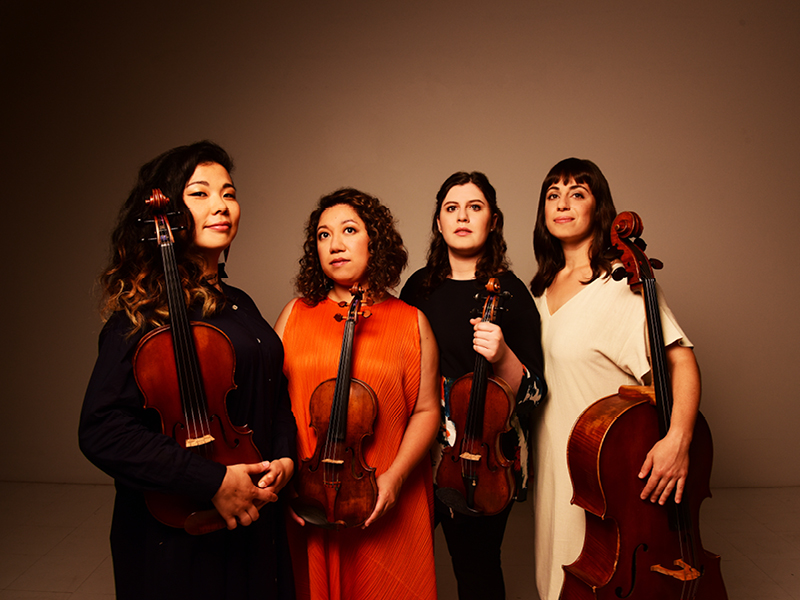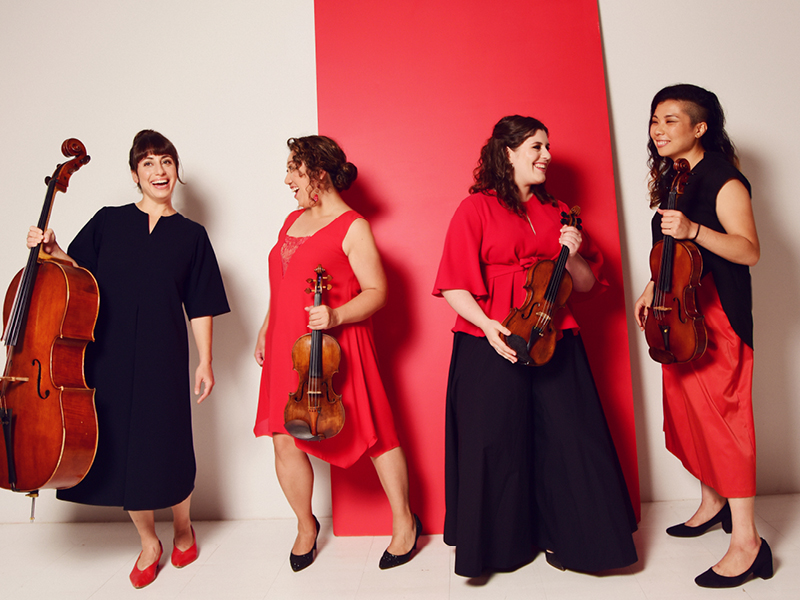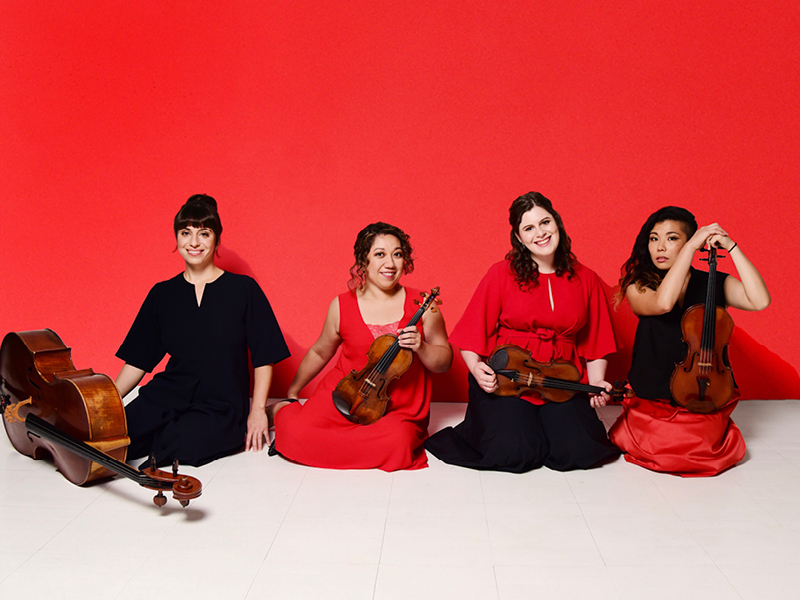



- This event has passed.
Virginia G. Piper Concert Series
Aizuri Quartet
The GRAMMY®-nominated Aizuri Quartet presents engaging, thought-provoking programs—branded by The New York Times as “genuinely exciting” and “imaginative.”
Thursday, Jan 27, 2022, 7:30 p.m.
tickets
- A: $45
- B: $35
- C: $25
- D: $15
About the Event
Praised by The Washington Post for “captivating” performances that draw from the musicians’ notable “meld of intellect, technique and emotions,” the Aizuri Quartet was awarded the Grand Prize and the CAG Management Prize at the 2018 M-Prize Chamber Arts Competition, along with top prizes at the 2017 Osaka International Chamber Music Competition in Japan and the 2015 Wigmore Hall International String Quartet Competition in London. The quartet’s critically acclaimed debut album, Blueprinting, featuring new works written for the Aizuri Quartet by five American composers, was released by New Amsterdam Records and nominated for a 2019 GRAMMY® in the category of Best Chamber Music/Small Ensemble Performance.
Through its engaging and thought-provoking programs—branded by The New York Times as “genuinely exciting” and “imaginative”—the quartet has garnered critical acclaim for bringing “a technical bravado and emotional power” to bold new commissions and for its “flawless” (San Diego Union-Tribune) performances of the great masterpieces of the past. In the 2019–20 season the group toured extensively across North America, giving debut appearances at Lincoln Center and at Carnegie Hall as part of CAG Winners Series.
Based in New York City, the Aizuri Quartet was the 2017–2018 MetLiveArts String Quartet-in-Residence at the Metropolitan Museum of Art, where the musicians presented five unique programs throughout the season, leading The New York Times to applaud them as “a quartet of expert collaborators, who cogently traverse a range of repertoire staples and modern works.” Previous residency engagements include the 2015–16 Ernst Stiefel String Quartet-in-Residence at the Caramoor Center for Music and the Arts, resident ensemble of the 2014 Ravinia Festival’s Steans Music Institute, and, from 2014–2016, the String Quartet-in-Residence at the Curtis Institute of Music in Philadelphia.
The quartet has performed extensively throughout North America, as well as in Europe, Japan, Mexico, Chile, Costa Rica, and Abu Dhabi, and it has commissioned and premiered new works by Pulitzer Prize-winner Caroline Shaw, Lembit Beecher, Paul Wiancko, Yevgeniy Sharlat, Gabriella Smith, Rene Orth, Michi Wiancko, and Alyssa Weinberg.
Program for What’s Past is Prologue
Hildegard von Bingen (1098–1179): Columba aspexit, arr. Alex Fortes (7 minutes)
Barbara Strozzi (1619–1677): L’usignuolo, arr. Alex Fortes (5 minutes)
Nina C. Young (b. 1984): Memento mori – Phase I (2013) (8 minutes)
Barbara Strozzi (1619–1677): L’amante modesto, arr. Alex Fortes (5 minutes)
Gabriella Smith (b. 1991): Carrot Revolution (2015) (11 minutes)
Intermission
Rhiannon Giddens (b.1977): “At the Purchaser’s Option” (2016) (4 minutes)
Eleanor Alberga (b. 1949): String Quartet No. 1 (1993) (21 minutes)
I. Détachéet martellato e zehr lebhaft und swing it man
II. Espressivo, with wonder and yearning
III. Frantically driven yet playful
About the Program
The phrase “What’s past is prologue” was famously spoken by Antonio in Shakespeare’s The Tempest and has become a modern shorthand for the notion that history sets the context for the present. For this Aizuri Quartet program, What’s Past is Prologue refers to music of the present moment that has sprung forth from the past.
The first half features pieces from the 12th and 17th centuries—by Hildegard von Bingen and Barbara Strozzi, respectively—paired with new music that draws inspiration from old music. Hildegard von Bingen’s plainchant Columba aspexit and Barbara Strozzi’s madrigals L’usignuolo (The Nightingale) and L’amante modesto (The Modest Lover) are illustrative of their bold, original approaches to vocal composition. They are heard here in new arrangements by Alex Fortes that were commissioned by the Aizuri Quartet.
Contemporary American composers Nina C. Young and Gabriella Smith reflect on the work of those who came before them as they push the string quartet medium toward the future. In Memento mori – Phase I, Young uses the first five notes of the D minor subject of Bach’s Art of Fugue as the musical material from which the piece is spun. An artistic reminder of the inevitability of death, she describes her Memento mori as “a meditation on life and the perception of time. In our daily activities, the constant influx of information, sensations, and stimuli saturates our consciousness. By stepping out of time, we can zoom in and out of our perceptual systems, allowing us to focus on their intricacies and beauty.”
Smith’s Carrot Revolution, written for the Aizuri Quartet in 2015, ushers the quartet through a collage of styles, playfully drawing grooves and flashes of melody out of a wide array of extended techniques. Inspired by the vast art collection of Dr. Albert C. Barnes and his unique approach to displaying paintings, metal objects, furniture, and pottery in unusual combinations, Smith writes: “I envisioned the piece as a celebration of that spirit of fresh observation and of new ways of looking at old things, such as the string quartet—a 200-year-old genre—as well as some of my even older musical influences (Bach, Perotin, Gregorian chant, Georgian folk songs, and Celtic fiddle tunes). The piece is a patchwork of my wildly contrasting influences and full of strange and unexpected juxtapositions and intersecting planes of sound, inspired by the way Barnes’ ensembles show old works in new contexts and draw connections between things we don’t think of as being related.”
Rhiannon Giddens makes a psychological journey into a troubled part of America’s past with her song “At the Purchaser’s Option” (from her album Freedom Highway, and arranged for string quartet by Jacob Garchik). The song was inspired by a 19th-century advertisement Giddens found for a 22-year-old female slave whose baby was also available for sale (“at the purchaser’s option”). Giddens, a musical historian, imagines the interior world of the slave whose soul is out of reach to her captors.
Finally, the British, Jamaican-born composer Eleanor Alberga draws inspiration from the scale and energy of the ancient, physical world. Her String Quartet No. 1 launches into outer space and explores the galaxy with brightness, virtuosity, and a sense of wonder. Alberga writes, “In the case of the first quartet I was propelled into an intense burst of creativity by a lecture on physics. The details of this lecture—who gave it, where it was given, and so on—are now lost to my memory, but what grabbed me was the realization that all matter—including our physical bodies—is made of the same stuff: star dust. So the first movement might be called ‘a fugue without a subject,’ as particles of this stardust swirl around each other, go their separate ways, collide, or merge. The second movement might be described as ‘stargazing from outer space,’ while the finale re-establishes gravity and earthbound energy.”
World Class Partner

Virginia G. Piper Concert Series supported by the Dayton Fowler Grafman Endowment for Classical Music
